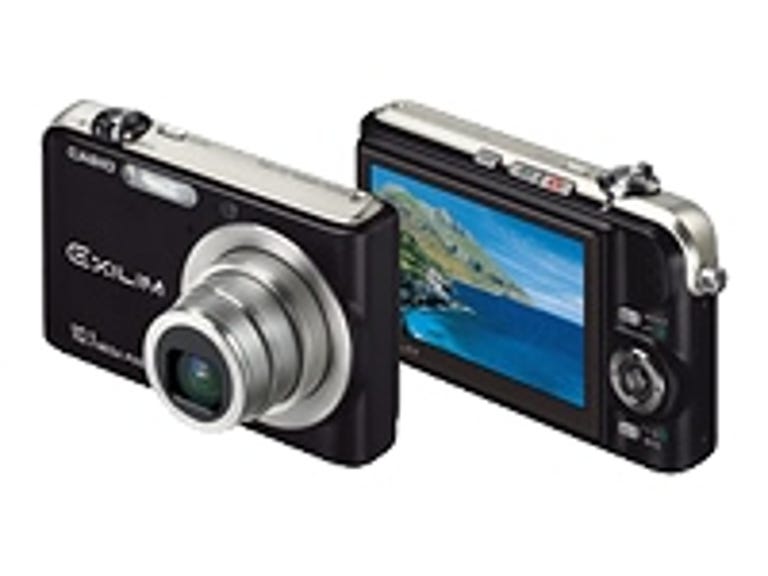 Why You Can Trust CNET
Why You Can Trust CNET Casio Exilim EX-Z1000 review: Casio Exilim EX-Z1000
This little high-res shooter puts big images in a small package. Read more in our review.
A 10-megapixel follow up to the 8-megapixel Casio Exilim EX-Z850, the Exilim EX-Z1000 is more than just a resolution bump in Casio's Exilim Z-series compact cameras. It's more of a fork in the road; for about the same price, the Casio Exilim EX-Z1000 forgoes the optical viewfinder, the manual exposure controls, and the shooting flexibility of the EX-Z850 in favor of a 16:9-aspect, a 2.8-inch LCD and a more refined interface.
Slightly larger than a business card and less than an inch across, the camera weighs just six ounces with a battery and memory card. The Casio Exilim EX-Z1000 sports a simple interface with very few buttons. The direction pad controls all of the camera's functions; you browse a list of the most commonly used image settings without touching the system menu. These settings are easy to check and change, thanks to a panel on the right-hand side of the screen.
The Good
The Bad
The Bottom Line
The LCD's brightness changes based on the brightness of the subject; for example, the entire display brightens when focusing on a TV screen. This feature is designed to make the display more readable in extreme illumination, but our reaction was mixed. It can be quite jarring when the screen suddenly brightens after you've locked and framed your photo, and it makes it difficult to judge whether the photo is properly exposed.
Beyond its 10-megapixel CCD, the Casio Exilim EX-Z1000 captures photos using a 38mm-to-114mm (35mm equivalent) lens with an aperture range of f/2.8 to f/5.4 and shutter speeds spanning 1/4 to 1/2,000 second. The camera has a sensitivity range of ISO 50 to ISO 400, though the High Sensitivity Best Shot mode can boost that setting to ISO 3,200. Like all Exilim cameras, the EX-Z1000 includes Casio's Anti-Shake DSP electronic image-stabilization system. Various settings, including ISO sensitivity, white balance, EV compensation, and even focus, can be manually changed through the camera's display panel. If you don't want to bother with those semimanual settings, the EX-Z1000 offers 34 scene presets, including novel options for photographing objects for online auction and head shots for different sizes of ID cards, as well as one for automatically retouching old photos on the camera.
Manual focus is easier to adjust on the EX-Z1000 than on most point-and-shoot cameras; you use the control pad's left and right buttons to change the focal length while framing the shot. The camera lacks aperture- and shutter-priority exposure modes. The camera also has a 25fps VGA movie mode for capturing videos with sound. You can record movies up to the capacity of your SD card.
Despite a very responsive shutter, the Casio Exilim EX-Z1000 takes just a bit too long between shots. After a quick 1.8 seconds from power-on to first shot, the camera took 3.5 seconds between every additional shot--even though shutter lag in bright light was a minimal 0.3 second and only 0.5 second in dim light. With the onboard flash enabled, that sluggish rate ballooned to 5.1 seconds between shots. The camera's 8MB buffer isn't enough to handle the burst throughput required by 10-megapixel images, so the EX-Z1000 had poorer continuous-shooting performance than other snapshot cameras: 0.4 full-resolution frame per second. You have a variety of options that can deliver speedier burst results, however.
The EX-Z1000 produced attractive images of well-lit subjects, but we saw no benefit to the extra resolution. In part, that's because the camera tended to overprocess its photos, resulting in compression artifacts and soft details. Our test shots were virtually noise-free up to ISO 200, though the ISO 400 setting produced a marked amount of fuzziness and grain. Low-light shots disappointed, with fuzzy details and large amounts of noise.
A slim design and an easy-to-use interface make the Casio Exilim EX-Z1000 appealing, but its overprocessed images and mixed performance depress its overall value. It's a nice camera, but it doesn't sufficiently distinguish itself from the rest of a class, which includes star pupils such as the Canon PowerShot SD630 and the Sony Cyber Shot DSC-T30.
(Shorter bars indicate better performance)
| Typical shot-to-shot time | Time to first shot | Shutter lag (typical) |
(Longer bars indicate better performance)
